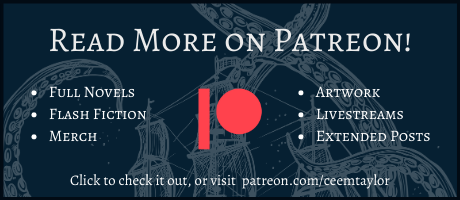
Welcome to Morning Pages — it’s time for a monthly roundup. I hope you’ve got your pencils sharpened and ready to write. Wanna join in on the fun? Read the prompt, set your timer* and get ready to let the words flow. Feel free to post the results of your work in the comments below where we chat about writing and (if the mood strikes us) get a craft discussion going.
If you want critique from other commenters, use #YESTHANKS in your comment. Otherwise, you can tell us about the flash fic and the process you went through to write it. And of course, I’m always open to hear what you think about my excerpts!
*you can write for as long as you want, but most folks choose 15-30 minutes.

What I learned this month: I’ve been crafting stories in my head since I was a little kid. I don’t think that’s a particularly unique trait—I think the unique bit is how I wrote so many of those stories down, and finished approximately none of them. I have endless writing notebooks kicking around drawers in my apartment, and because the writing isn’t quality (look, some of them date back to middle school) I tend to overlook them as sources of inspiration.
The thing is… there’s nothing wrong with the ideas I came up with. The flaws were always in the execution—because it takes a heckin’ long time to develop any kind of writing craft, and I certainly wasn’t there when I jotted down the ideas for those stories.
But flaws in craft have nothing to do with concept flaws, and I’m starting to see that I shouldn’t stop myself from revisiting old ideas just because the dialogue is wooden or the descriptions are awkward. The fun part about rereading my writing notebooks is revisiting the stories, not how they’re told. And now, years later, I finally have the ability to retell them the way they originally deserved to be written.
I’m not sure I’ll end up throwing any of these old ideas on the backburner pile, but hey—I might. Either way, it was worth revisiting one of them in the short after which this roundup is named. Check out Righting Wrongs for a window into Teenage!Cee’s head.

The Prompts:
“Put the main character from one of your books into the circus.”
Turns out, Arden from the Oceana ‘verse is a decent aerialist.
“It will take the rest of my life to right the wrongs I’ve done.”
Revisiting Crecia: a world I built when I was a kid.
“Beware the Six-Toed Cat.”
Anya from Weaver doesn’t put much stock in advice from psychics. (Maybe she should.)
“If you find yourself in need of an answer, blow out a candle and ask the smoke. But ask quickly–it can’t stay around for long.”
An old King wonders whether he was right to wear the crown.
“The island is made of skeletons, creatures big and small polished into shining bone roads. The people who live there are peaceful. So far.”
“Albatross:” A shipwrecked sailor pays for his errors.
“You’re Spoiling Me.”
Neveshir from Dark Arm of the Maker has a hard time believing he deserves kindness.
Picture Prompts

“Monolith:” Arden and Val from the Oceana ‘Verse explore a foreign land.

Get Involved!
Answer the prompts or dive straight in and respond to others’ comments — let’s share our knowledge, our experience, and have a discussion we can all learn from! Don’t want to miss a post? Subscribe to the blog in the sidebar to get notified about new posts.
Today’s questions:
- Have you ever rewritten a story you started as a kid? How much time passed between the original idea occurring to you and the rewrite happening?
- Were you happy with the end result? Why/why not?
Looking for more writing? Become a Patron!
In addition to extra flash fiction (at least once a week), my Patreon hosts my full-length novels, artwork, behind-the-scenes worldbuilding, and more. Click below to check out the tiers I offer and support the blog!
